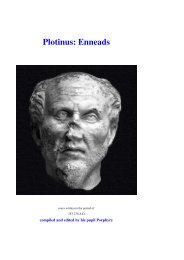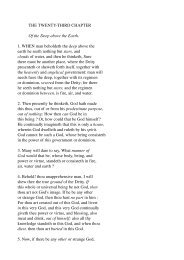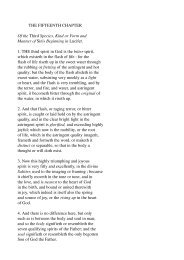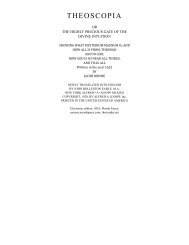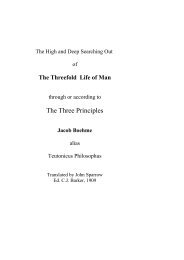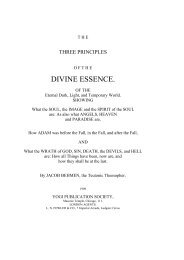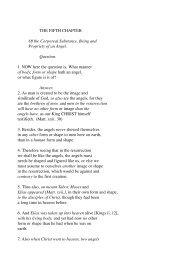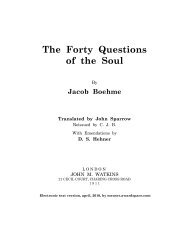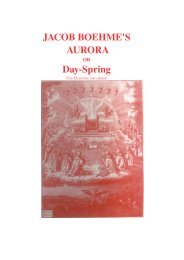Gerald Massey's Lectures - Society in evolution - Awardspace
Gerald Massey's Lectures - Society in evolution - Awardspace
Gerald Massey's Lectures - Society in evolution - Awardspace
Create successful ePaper yourself
Turn your PDF publications into a flip-book with our unique Google optimized e-Paper software.
common <strong>in</strong> the tombs of Egypt. The name of it, "Uta," signifies salvation; and to be<br />
saved was to be preserved as a mummy wait<strong>in</strong>g to be reproduced or transformed for<br />
another life. The eye be<strong>in</strong>g a mirror that reflects the image, it was adopted as a type of<br />
repetition and reproduction. Thus the Eye of Horus is the Mother of Horus, and the shoot<br />
of new life <strong>in</strong> the potato comes from the "eye"--as the place of reproduction. One word<br />
serves for both eye and seed <strong>in</strong> the Ute language. The Egyptians fed the eye with oil. And<br />
fill<strong>in</strong>g the "Eye of Horus" is synonymous with br<strong>in</strong>g<strong>in</strong>g an offer<strong>in</strong>g of sacred oil. The eye<br />
be<strong>in</strong>g the lamp of light to the body, it was supplied with that which would produce and<br />
reproduce the light. Thus, by aid of Egypt, we can understand why the primitive race <strong>in</strong><br />
Brita<strong>in</strong>, and still further north, were accustomed to fill the cups and eyes carved on the<br />
cap-stones that covered their buried dead with offer<strong>in</strong>gs of fat. They were fill<strong>in</strong>g the lamp<br />
of light for the gloom of the grave, and feed<strong>in</strong>g the eye as an emblem of repetition or<br />
reproduction. The symbolism still survives when candles are placed <strong>in</strong> the hands of the<br />
corpse, or left with the dead <strong>in</strong> the tomb. And <strong>in</strong> ancient Egypt the candle was<br />
synonymous with reproduction.<br />
It is an extant custom, both with the Kaffirs and the English, to cut the hair from the tail<br />
of a calf when it is be<strong>in</strong>g weaned, and stuff it <strong>in</strong>to the ear of its mother. The hair be<strong>in</strong>g a<br />
symbol of reproduction, the action denotes a desire for plenty of milk or future progeny,<br />
whilst stuff<strong>in</strong>g it <strong>in</strong>to the ear signifies a wish that the prayer may be heard. A dr<strong>in</strong>k on the<br />
morn<strong>in</strong>g after be<strong>in</strong>g <strong>in</strong>toxicated is called "a hair of the dog that bit you"! This means a<br />
repetition of the dose; and as a symbol of reproduction, hair, <strong>in</strong> one shape or another, was<br />
buried with the dead. Of course the primary type of hair is the sk<strong>in</strong>--<strong>in</strong> which the dead<br />
were wrapped for preservation, transformation, and rebirth. In the Egyptian Ritual the<br />
deceased says to his God, "Thou makest for me a sk<strong>in</strong>." This God is characterized as the<br />
"Lord of the numerous transformations of the sk<strong>in</strong>," which had become a type of renewal,<br />
on account of its shedd<strong>in</strong>g and renew<strong>in</strong>g the hair. The sk<strong>in</strong> is needed because he has to<br />
pass the waylayers who cause annihilation to those who are enveloped. The later shoe,<br />
follow<strong>in</strong>g the sk<strong>in</strong>, is also a type of renewal and reproduction; as such it was placed on<br />
the feet of the dead, and is still thrown for good luck after the newly married pair--good<br />
luck mean<strong>in</strong>g plenty of progeny. The horn of the stag or re<strong>in</strong>deer was likewise a type of<br />
renewal, com<strong>in</strong>g of itself, as does the hair of the sk<strong>in</strong>. Hor-Apollo tells us the stag's horn<br />
was a symbol of permanence, because of its annual self-reproduction. And when the<br />
Greenlander has suffered from an exhaust<strong>in</strong>g illness, and he recovers his health, he is said<br />
to have lost his former soul, and to have had it replaced by that of a young child or a<br />
re<strong>in</strong>deer. In the bone-caves of France adult skulls have been discovered which were<br />
trepanned <strong>in</strong> the life-time of the owners; and <strong>in</strong>to these the bones of young children had<br />
been <strong>in</strong>serted after death--these be<strong>in</strong>g typical of rejuvenescence and renewal from<br />
childhood--as we learn from the hieroglyphics of Egypt.<br />
In all likelihood the Dog was the first animal to come under the dom<strong>in</strong>ion of man, his<br />
earliest four-footed friend; his primary ally <strong>in</strong> the work of progress and civilization. He<br />
hunted for the men of the Kitchen-middens; he was the guide and guard of man <strong>in</strong> the<br />
palæolithic age, and he was sacrificed to become the typical guide of the poor cavedwellers<br />
when they got benighted <strong>in</strong> the dark of death. The bones of the dog have been<br />
found buried with the human skeleton <strong>in</strong> a very ancient cave of the Pyrenees; <strong>in</strong> Belgium;<br />
and <strong>in</strong> Brita<strong>in</strong>; show<strong>in</strong>g that at a period most remote the dog was looked upon as a k<strong>in</strong>d of<br />
Psychopompus, an <strong>in</strong>telligent shower of the way, like Sut-Anup, the golden dog or jackal<br />
of Egypt, and Hermes <strong>in</strong> Greece,--the Dog-star <strong>in</strong> the dark of death--a guide to show the<br />
way. "I have provided myself with a dog's head," says the Egyptian deceased <strong>in</strong> pass<strong>in</strong>g<br />
through the 10th gate of Elysium. In like manner English bishops used to be buried with a<br />
dog at their feet <strong>in</strong> the coff<strong>in</strong>. They, too, were provided with a dog's head--or a dog to<br />
show them the way! Of course the dog would not have been needed as a typical guide to<br />
show them the way if it had not been believed or assumed that there was a way through



